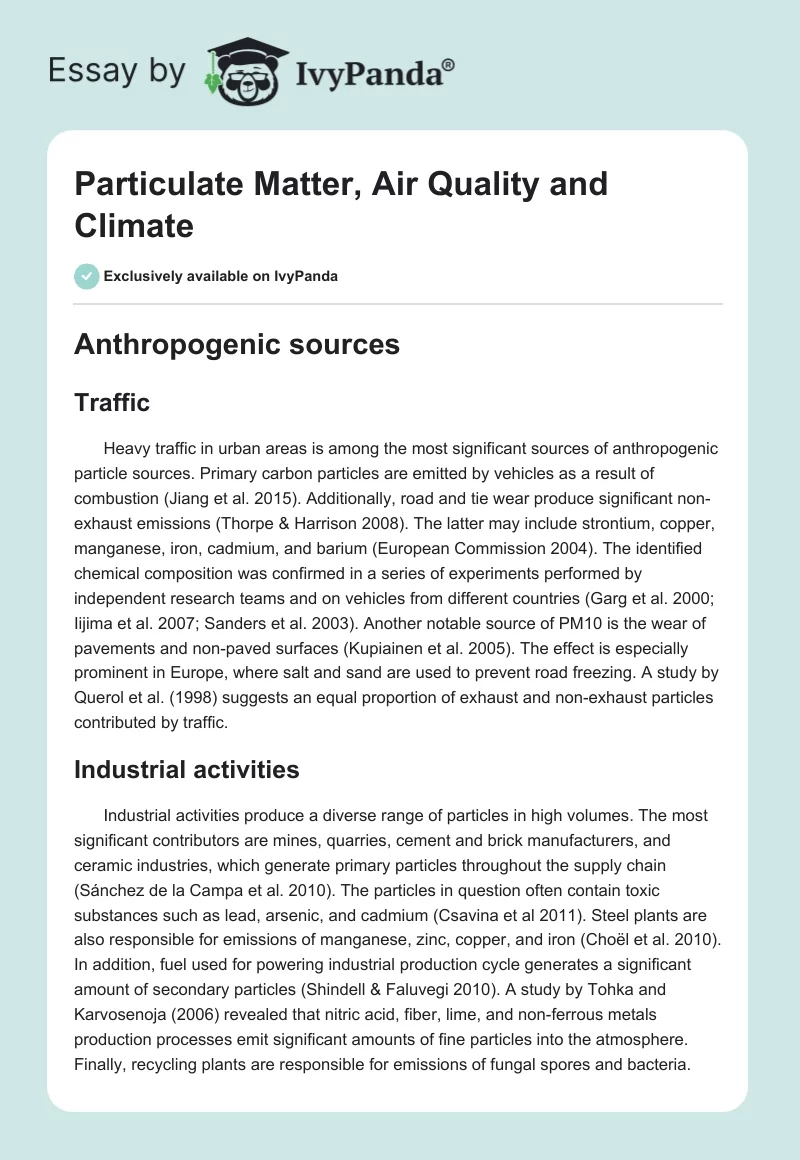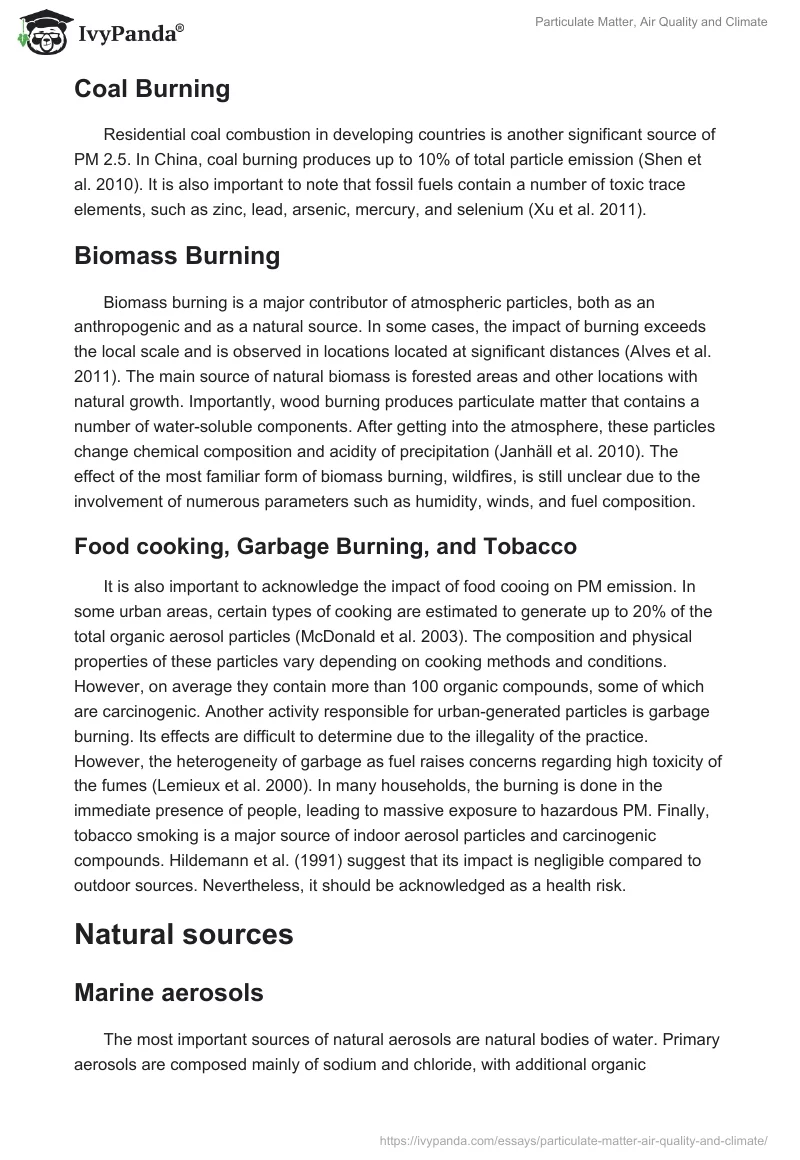Anthropogenic sources
Traffic
Heavy traffic in urban areas is among the most significant sources of anthropogenic particle sources. Primary carbon particles are emitted by vehicles as a result of combustion (Jiang et al. 2015). Additionally, road and tie wear produce significant non-exhaust emissions (Thorpe & Harrison 2008). The latter may include strontium, copper, manganese, iron, cadmium, and barium (European Commission 2004). The identified chemical composition was confirmed in a series of experiments performed by independent research teams and on vehicles from different countries (Garg et al. 2000; Iijima et al. 2007; Sanders et al. 2003). Another notable source of PM10 is the wear of pavements and non-paved surfaces (Kupiainen et al. 2005). The effect is especially prominent in Europe, where salt and sand are used to prevent road freezing. A study by Querol et al. (1998) suggests an equal proportion of exhaust and non-exhaust particles contributed by traffic.
Industrial activities
Industrial activities produce a diverse range of particles in high volumes. The most significant contributors are mines, quarries, cement and brick manufacturers, and ceramic industries, which generate primary particles throughout the supply chain (Sánchez de la Campa et al. 2010). The particles in question often contain toxic substances such as lead, arsenic, and cadmium (Csavina et al 2011). Steel plants are also responsible for emissions of manganese, zinc, copper, and iron (Choël et al. 2010). In addition, fuel used for powering industrial production cycle generates a significant amount of secondary particles (Shindell & Faluvegi 2010). A study by Tohka and Karvosenoja (2006) revealed that nitric acid, fiber, lime, and non-ferrous metals production processes emit significant amounts of fine particles into the atmosphere. Finally, recycling plants are responsible for emissions of fungal spores and bacteria.
Coal Burning
Residential coal combustion in developing countries is another significant source of PM 2.5. In China, coal burning produces up to 10% of total particle emission (Shen et al. 2010). It is also important to note that fossil fuels contain a number of toxic trace elements, such as zinc, lead, arsenic, mercury, and selenium (Xu et al. 2011).
Biomass Burning
Biomass burning is a major contributor of atmospheric particles, both as an anthropogenic and as a natural source. In some cases, the impact of burning exceeds the local scale and is observed in locations located at significant distances (Alves et al. 2011). The main source of natural biomass is forested areas and other locations with natural growth. Importantly, wood burning produces particulate matter that contains a number of water-soluble components. After getting into the atmosphere, these particles change chemical composition and acidity of precipitation (Janhäll et al. 2010). The effect of the most familiar form of biomass burning, wildfires, is still unclear due to the involvement of numerous parameters such as humidity, winds, and fuel composition.
Food cooking, Garbage Burning, and Tobacco
It is also important to acknowledge the impact of food cooing on PM emission. In some urban areas, certain types of cooking are estimated to generate up to 20% of the total organic aerosol particles (McDonald et al. 2003). The composition and physical properties of these particles vary depending on cooking methods and conditions. However, on average they contain more than 100 organic compounds, some of which are carcinogenic. Another activity responsible for urban-generated particles is garbage burning. Its effects are difficult to determine due to the illegality of the practice. However, the heterogeneity of garbage as fuel raises concerns regarding high toxicity of the fumes (Lemieux et al. 2000). In many households, the burning is done in the immediate presence of people, leading to massive exposure to hazardous PM. Finally, tobacco smoking is a major source of indoor aerosol particles and carcinogenic compounds. Hildemann et al. (1991) suggest that its impact is negligible compared to outdoor sources. Nevertheless, it should be acknowledged as a health risk.
Natural sources
Marine aerosols
The most important sources of natural aerosols are natural bodies of water. Primary aerosols are composed mainly of sodium and chloride, with additional organic compounds produced by phytoplankton (Yang et al. 2011). Primary aerosols are formed as a result of bubble eruption on the water surface. Particles produced in this way are mostly coarse with occasional fine fractions that can be found at relatively high altitudes (Yang et al. 2011). It has been estimated that the total contribution of sea spray aerosols is comparable to that of fossil fuel burning.
Mineral Dust
Winds on the Earth’s surface generate mineral fraction that serves as a major source of natural aerosols. These particles originate mainly from dry surfaces, with global dust belt being the most significant contributor. Chemical composition of particles varies depending on soil composition and other environmental factors. Available data suggests a significant increase in amount of mineral dust generated globally (Mulitza et al. 2010).
Biogenic Emissions
Gases emitted by microorganisms and vegetation contain particles known as biogenic aerosols. Unlike mineral-based particles, biogenic ones have complex chemical composition (Winiwarter et al. 2009). This factor contributes to the formation of secondary organic aerosol. According to the latest estimates, the resulting effect is up to ten times greater than its respective anthropogenic counterpart (Atkinson & Arey 2003). However, the results are inconclusive due to the involvement of numerous variables.
Volcanic Eruptions
Volcanic activity is among the most recognizable natural sources of PM emissions. They have a massive effect on acidity of precipitation and constitute a major risk to air traffic. However, the impact is usually limited to specific events. Eruptions produce both primary and secondary aerosols. Importantly, eruptions have the capacity to deliver PM to the stratosphere, which creates major environmental effects (Gao et al. 2007). These effects may last for several years, which is significant compared to a one-week lifespan of more common tropospheric aerosols.
Reference List
Alves, C, Vicente, A, Nunes, T, Gonçalves, C, Fernandes, AP, Mirante, F, Tarelho, L, Sánchez De La Campa, AM, Querol, X, Caseiro, A, Monteiro, C, Evtyugina, M & Pio, C 2011, ‘Summer 2009 wildfires in Portugal: emission of trace gases and aerosol composition’, Atmospheric Environment, vol. 45, no. 3, pp. 641-649.
Atkinson, R & Arey, J 2003, ‘Gas-phase tropospheric chemistry of biogenic volatile organic compounds: a review’, Atmospheric Environment, vol. 37, pp. 197-219.
Choël, M, Deboudt, K & Flament, P 2010, ‘Development of time-resolved description of aerosol properties at the particle scale during an episode of industrial pollution plume’, Water, Air, & Soil Pollution, vol. 209, no. 1-4, pp. 93-107.
Csavina, J, Landázuri, A, Wonaschütz, A, Rine, K, Rheinheimer, P, Barbaris, B, Conant,W, Sáez, A & Betterton, E 2011, ‘Metal and metalloid contaminants in atmospheric aerosols from mining operations’, Water, Air, & Soil Pollution, vol. 221, no. 1-4, pp. 145-157.
European Commission 2004,Second position paper on particulate matter. Web.
Gao, C, Oman, L, Robock, A & Stenchikov, GL 2007, ‘Atmospheric volcanic loading derived from bipolar ice cores: accounting for the spatial distribution of volcanic deposition’, Journal of Geophysical Research: Atmospheres, vol. 112, pp. 1-18.
Garg, BD, Cadle, SH, Mulawa, PA, Groblicki, PJ, Laroo, C & Parr, GA, 2000, ‘Brake wear particulate matter emissions’, Environmental Science & Technology, vol. 34, no. 21, pp. 4463-4469.
Hildemann, LM, Markowski, GR & Cass, GR 1991, ‘Chemical composition of emissions from urban sources of fine organic aerosol’, Environmental Science & Technology, vol. 25, no. 4, pp. 744-759.
Iijima, A, Sato, K, Yano, K, Tago, H, Kato, M, Kimura, H & Furuta, N 2007, ‘Particle size and composition distribution analysis of automotive brake abrasion dusts for the evaluation of antimony sources of airborne particulate matter’, Atmospheric Environment, vol. 41, no. 23, pp. 4908-4919.
Janhäll, S, Andreae, MO & Pöschl, U 2010, ‘Biomass burning aerosol emissions from vegetation fires: particle number and mass emission factors and size distributions’, Atmospheric Chemistry and Physics, vol. 10, no. 3, pp. 1427-1439.
Jiang, M, Marr, LC, Dunlea, EJ, Herndon, SC, Jayne, JT, Kolb, CE, Knighton, WB, Rogers, TM, Zavala, M, Molina, LT & Molina, MJ 2005, ‘Vehicle fleet emissions of black carbon, polycyclic aromatic hydrocarbons, and other pollutants measured by a mobile laboratory in Mexico City’, Atmospheric Chemistry and Physics, vol. 5, no. 12, pp. 3377-3387.
Kupiainen, KJ, Tervahattu, H, Räisänen, M, Mäkelä, T, Aurela, M & Hillamo, R 2005, ‘Size and composition of airborne particles from pavement wear, tires, and traction sanding’, Environmental Science & Technology, vol. 39, no. 3, pp. 699-706.
Lemieux, PM, Gullett, BK, Lutes, CC, Winterrowd, CK & Winters, DL 2003, ‘Variables affecting emissions of PCDD/Fs from uncontrolled combustion of household waste in barrels’, Journal of the Air & Waste Management Association, vol. 53, no. 5, pp. 523-531.
McDonald, JD, Zielinska, B, Fujita, EM, Sagebiel, JC, Chow, JC & Watson, JG 2003, ‘Emissions from charbroiling and grilling of chicken and beef’, Journal of the Air & Waste Management Association, vol. 53, no. 2, pp. 185-194.
Mulitza, S, Heslop, D, Pittauerova, D, Fischer, HW, Meyer, I, Stuut, JB, Zabel, M, Mollenhauer, G, Collins, JA & Kuhnert, H 2010, ‘Increase in African dust flux at the onset of commercial agriculture in the Sahel region’, Nature, vol. 466, no. 7303, pp. 226-228.
Querol, X, Alastuey, A, Puicercus, JA, Mantilla, E, Miro, JV, Lopez-Soler, A, Plana, F & Artiñano, B 1998, ‘Seasonal evolution of suspended particles around a large coal-fired power station: particulate levels and sources’, Atmospheric Environment, vol. 32, no. 11, pp. 1963-1978.
Sánchez de la Campa, AM, de La Rosa, JD, González-Castanedo, Y, Fernández-Camacho, R, Alastuey, A, Querol, X, & xPio, C 2010, ‘High concentrations of heavy metals in PM from ceramic factories of Southern Spain’, Atmospheric Research, vol. 96, pp. 633–644.
Sanders, PG, Xu, N, Dalka, TM & Maricq, MM 2003, ‘Airborne brake wear debris: size distributions, composition, and a comparison of dynamometer and vehicle tests’, Environmental Science & Technology, vol. 37, no. 18, pp. 4060-4069.
Shen, G, Wang, W, Yang, Y, Zhu, C, Min, Y, Xue, M, Ding, J, Li, W, Wang, B, Shen, H, Wang, R, Wang, X & Tao, S 2010. Emission factors and particulate matter size distribution of polycyclic aromatic hydrocarbons from residential coal combustions in rural Northern China. Atmospheric Environment, vol. 44, pp. 5237–5243.
Shindell, D & Faluvegi, G 2010, ‘The net climate impact of coal-fired power plant emissions’, Atmospheric Chemistry and Physics, vol. 10, no. 7, pp. 3247-3260.
Thorpe, A & Harrison, RM, 2008, ‘Sources and properties of non-exhaust particulate matter from road traffic: a review’, Science of the Total Environment, vol. 400, no. 1-3, pp. 270-282.
Tohka, A & Karvosenoja, N 2006, Fine particle emissions and emission reduction potential in Finnish industrial processes. Web.
Winiwarter, W, Bauer, H, Caseiro, A & Puxbaum, H 2009, ‘Quantifying emissions of primary biological aerosol particle mass in Europe’, Atmospheric Environment, vol. 43, no. 7, pp. 1403-1409.
Xu, M, Yu, D, Yao, H, Liu, X & Qiao, Y 2011, ‘Coal combustion-generated aerosols: formation and properties’, Proceedings of the Combustion Institute, vol. 33, no. 1, pp. 1681-1697.
Yang, GP, Zhang, HH, Zhou, LM & Yang, J 2011, ‘Temporal and spatial variations of dimethylsulfide (DMS) and dimethylsulfoniopropionate (DMSP) in the East China Sea and the Yellow Sea’, Continental Shelf Research, vol. 31, no. 13, pp. 1325-1335.


